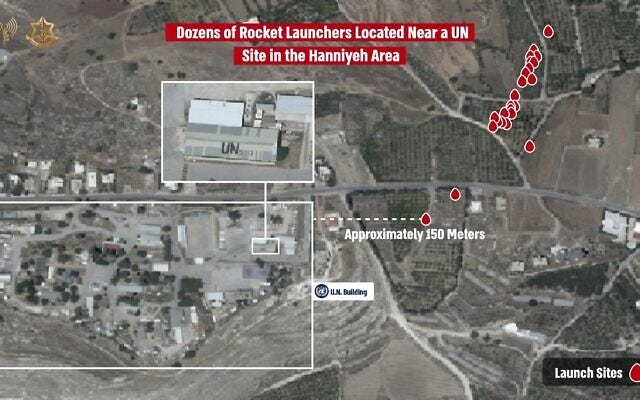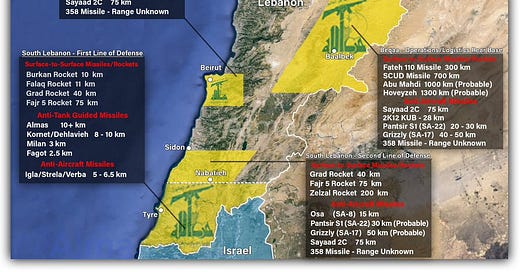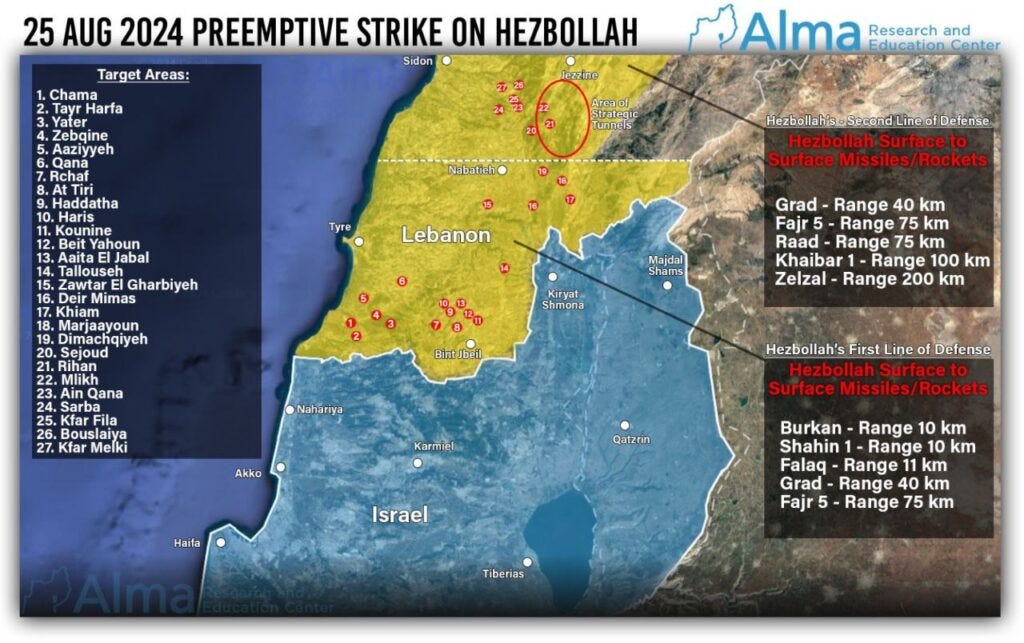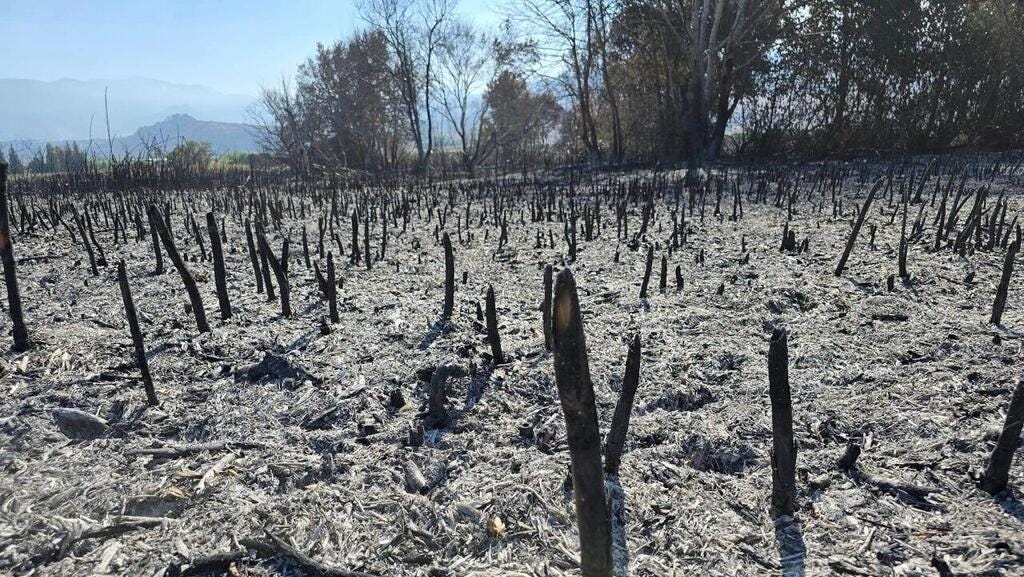In the wake of Hezbollah’s failed attempt at retaliation for Israel’s fruitful assassination of Fuad Shukr and the so far failure of ceasefire negotiations with Hamas, now is the time to take a close look at:
Israel’s present strategic goals
Key facts on the ground today
Strategies for success
Israel’s Strategic Goals
As I see it, Israel should now pursue five main goals:
Ensure that Hamas, or a similar organization, will never govern Gaza again while also doing everything possible consistent with that to bring as many hostages as possible home.
Find a “day after” solution that does not include permanent Israeli governance or management of the Gazan population, that incorporates assistance from other Arab countries, and that opens the door for Saudi Arabia to recognize Israel.
Restore the ability of Israelis to live safely along, and near, Israel’s northern border with Lebanon while also significantly degrading Hezbollah’s ability to threaten Israel as a whole.
Prevent Iran from becoming a nuclear power.
Reduce antisemitism in the Diaspora.
Key Present Facts on the Ground Related to Israel’s Strategic Goals
Hamas’ large scale military units have been destroyed and its ability to launch significant numbers of missiles eliminated. However, Hamas still has many soldiers under its command who now mainly pursue smaller scale attacks using improvised explosive devices (IEDs) on roads and in buildings.
Hamas still maintains a form of governance over the civilian population by virtue of its influence on humanitarian goods distribution and through past targeted assassinations of rising opposition leaders and the threat of more.
Hamas’ leader, Yahya Sinwar, survives although many of his cronies and important commanders are dead.
Israel has discovered and destroyed more than 150 tunnels used by Hamas for smuggling (at least one capable of driving trucks through) that led from Egypt to Gaza. For many years, Hamas used the tunnels to bring weapons and construction material into Gaza. It used the weapons to wage multiple terror campaigns against Israel and to maintain internal control. Hamas used the construction material to protect its organization by building a vast array of tunnels that rivals the New York subway system in size and scope but did not build one shelter for civilian protection.
The area that encompasses this border area, and that the IDF now occupies, is called the Philadelphi Corridor. It is close to nine miles long and a portion of it divides Rafah from Egypt. For decades, Egypt abdicated its responsibility, either intentionally and/or due to massive bribery, to prevent the flow of weaponry and materials to Hamas through and under the corridor.
Israel has built four bases for housing hundreds of IDF soldiers in the Netzarim Corridor, a four-mile strip of land in central Gaza running from Israel’s border to the Mediterranean Sea in Gaza that splits Gaza into a northern and southern zone. The IDF considers this corridor, in which it has constructed a road, necessary for sending aid into Gaza securely and important for launching raids into areas in northern and southern Gaza where Hamas congregates and tries to reconstitute its forces.
Of the hostages taken October 7 (plus two imprisoned and two IDF soldiers killed years before), probably no more than seventy-two remain alive inside Gaza and likely Hamas still holds the bodies of thirty-four or more who died there. On August 27, the IDF rescued one Israeli Bedouin hostage that Hamas held from a tunnel in Rafah.
Indirect negotiations—mediated by the United States, Qatar, and Egypt—have been ongoing for some time. Over the last few weeks, they have mostly taken the form of American proposals accepted by Israel and then rejected by Hamas. More recently, in mid-August, Israel and the mediators had an intensive set of discussions in Doha after which U.S. Secretary of State Antony Blinken said that Israel had accepted U.S. bridging proposals and called upon Hamas to do the same. Hamas did not do so. Then, on August 25, further high-level talk were held in Cairo and once again Hamas reportedly rejected the deal on the table (America is still conveying some optimism as further talks at a lower level continue and reports leak out—some suggesting that significant rifts remain over things like understandable Israeli insistence on Israeli participation in a control mechanism to prevent future weapon smuggling into Gaza or armed terrorists returning to northern Gaza, and other reports suggesting the the wrangling is more over the names of Israeli hostages and Palestinian terrorists that will be released.
The number of civilian deaths occurring in Gaza has seen an extremely significant downward drop. Those that continue to occur, as has been the case all along, are due to Hamas’ intentional use of their lost lives as a tactical asset designed to impact world opinion and thereby limit and modify Israel’s ability to root out the terrorists—of course resulting then resulting in more IDF soldiers dying.
During the early hours of August 25, before the high-level ceasefire talks in Cairo started, Hezbollah prepared a potentially devastating missile and drone attack on Israel scheduled to start at 5:00 AM. Hezbollah planned to attack two Israeli intelligence headquarters in the greater Tel Aviv area, a large IDF military airfield in northern Israel, other military sites in northern Israel and quite possibly (despite Hezbollah’s denials) civilian targets. Israel detected the planned onslaught and struck first at 4:30 AM and again at 4:45 am with 100 warplanes, blunting Hezbollah’s planned strike and successfully destroying 6,000 missiles being readied to fire or in storage as well as numerous launchers (ninety percent of which Hezbollah placed very near civilians or UN facilities). However, the IDF restricted its fire to southern Lebanon in hopes of limiting the likelihood that a regional war would break out. Soon thereafter, Hezbollah fired about 220 missiles and twenty drones but achieved little other than the destruction of a chicken coup (for which it is being derided by some in the Arab world). Now, Nasrallah disingenuously says that stage one of its response to the death of Shukr has been completed successfully, but leaves open the possibility of more to come.
More than 70,000 Israelis remain evacuated from northern Israel, with many feeling abandoned by their government and participating in a growing movement designed to push Israel to take a more active stance against Hezbollah that would allow them to return to their homes and to retake Israeli sovereignty over the three mile-wide swath of land stretching from Israel’s border with Lebanon southward now barren due to Hezbollah’s murderous missile fire.
Iran has not given up its threat of retaliation against Israel for the killing of Ismail Haniyeh, although there are some reports that its leadership may be deterred by America’s deployment of two aircraft carrier groups and one missile submarine to the region.
Iran is steadily moving forward with its development of nuclear weapons and the means to fire them at Israel. Very likely, if not stopped, it will reach its goal of a deliverable nuclear weapon in the next several months, and almost certainly now possesses weapon grade enriched uranium.
Strategies for Achieving Success
First, I must caution you, the following consists of my opinions informed by the facts I see on the ground, what I listen to, experts I have spoken with, and what I read. I provide it to you not as a prediction or a suggestion to Israel’s government but to stimulate your own thinking and to demonstrate the interconnectivity of threats and solutions that Israel must navigate. Therefore, it might be best to consider my thoughts as sort of a roadmap from which your own analysis may detour and as a lens through which you might view events in the coming days and weeks.
Hamas and Gaza
Israel must fight as long and as hard as possible to ensure Hamas can no longer govern Gaza. To do that, it must maintain control of the Philadelphi Corridor in a manner that prevents more weapons from entering Gaza. Therefore, because Egypt has proven its inability or unwillingness to do that, the IDF must maintain a military presence there. To a lesser, but still important degree, the IDF must also monitor those Gazans seeking to return to northern Gaza to make sure they are not armed because resurgence of an armed terrorist force in northern Gaza, due to its proximity to heavier concentrations of Israeli towns and cities than farther south, presents great danger to many Israeli civilians. Thus, think of the Philadelphi and Netzarim corridors as two Israeli defenses against Hamas reforming and governing Gaza again and along with a third defensive measure—a defensive barrier along the border—three collective measures that will make it much more difficult for Hamas to mount terrorist operations and launch missile strikes against Israel in the future.
As for the remaining hostages, sadly I am not optimistic. Lately, the negotiations have mostly taken the form of American proposals that Israel agrees to and to which Hamas says no. While there is obvious pressure placed on Israel’s government from without and within, there is little discernable pressure on Hamas. In essence, Hamas has been calling the shots with Israel the supplicant. Perhaps this will lead to a hostage release under terms that will allow Israel to achieve its necessary goals expressed above, but I am doubtful. And I am even more doubtful that an agreement will produce release of all the hostages since Phase One only calls for release of some of them (somewhere between a quarter and forty percent of those thought to still be living). Since most assuredly the price for hostage releases in Phase Two will go way up, I am very pessimistic that those not initially released in the deal now being discussed will survive. In my mind, this leaves only one choice—continued pressure, continued rescue attempts, clear enunciation of Israel’s unwavering red lines in Gaza. And it is important to make clear that time is not on Hamas’ side because Israel’s deal will get worse for Hamas not better as more Israeli soldiers die in service of their country. Steely determination is the only way to force Hamas to make concessions. And it is likely the only chance that those hostages not released in the first tranche of the deal presently being discussed have.
Also crucial, is rebuilding governance within Gaza. Those that say fighting must stop because the suffering in Gaza will create more terrorists from the civilian populace have a point—but not a particularly good one because such a incentivizes other terrorists in other locations to use the death of civilians as tactical assets (not just shields) which will cause more lives to be lost than if the practice is proven unsuccessful now. Furthermore, on October 6, Hamas had in its sway plenty of terrorists, and more were being manufactured every day by the twisted educational system Hamas created and UNWRA facilitated. Thus, it is vitally important to both pull humanitarian aid from Hamas’ control (this likely means the United Nations too) and move as quickly as possible to reinstitute and revitalize the educational system in Gaza. Likely this will require enticing outside Arab involvement and IDF responsibility for security in the short term. All of this can only be accomplished if the IDF continues to root out remaining Hamas battle formations, weaponry, and leaders.
How can Saudi Arabia and the UAE be enticed to become willing partners? By Israel clearly stating that Palestinian self-determination is not an entitlement but that it can be earned and then delineating what would be necessary to do that—a de-radicalized education system, end of pay-to-slay support for terrorists and their families, acceptance that such a state would be demilitarized, insistence on stable governance proven by the passage of time, and most importantly that the Palestinians recognize Israel as the state of the Jewish people thereby accepting that Palestinians do not have a “right to return.” To help accomplish these tasks that likely would take a decade or more, Israel should invite the participation of Saudi Arabia and the UAE in establishing a system of governance and education in Gaza, accompanied by their financing an economic resurgence, that would offer a beacon of hope and guide for the Palestinian Authority to reform its practices in the West Bank.
Why would Saudi Arabia and the UAE do this? Because they desperately want to form a coalition with the United States and Israel that will stand up to Iran. Would they be willing to do so? A Politico article that hinted of a change in Saudi thinking was referenced in a Jerusalem Post article dated August 26, in which the author stated that Saudi Arabia has modified its prerequisite for normalizing relations with Israel from “firm approval from Israel for the establishment of a Palestinian state” to requiring “a credible path toward a Palestinian state.” Requiring that path to be one of peace with, and acceptance of, Israel proven by conduct not just words, especially in light of October 7 and Iran’s and its proxies conduct since then, would be an agreement worth pursuing.
Hezbollah
The day after Hamas attacked Israel on October 7, Hezbollah initiated a relentless bombardment of Israel that has not abated. During the almost eleven months that have passed since, Hezbollah has fired 7,000 rockets and drones at Israeli targets—some military and many civilian. Fully a fifth of Israel lies within the zone of danger of the weapons Hezbollah has used, the remaining four-fifths of the country could be struck by other weapons in Hezbollah’s arsenal. Furthermore, hardly a day has gone by since October 8 that Hezbollah has not fired elements of its arsenal into Israel. Even Israelis that live outside of the evacuated areas face the danger of missile and drone strikes every hour of every day. Simply put, the situation is intolerable.
And while what Israel accomplished on August 25, diminishing Hezbollah’s planned attack from up to 1500 missiles to little more than 200, should be lauded for its effectiveness—it was only a tactical success not a strategic victory. It did not change the future. Hezbollah will learn lessons from its failure and will try again.
Meanwhile, its missiles and drones will continue to fly into Israel—some days 25, some days 50, and some 100 or more. Those that get through Iron Dome will explode on roadways, destroy homes, and damage buildings with little warning. Israelis will die, the region’s economy will continue to decline, and the land near the border will remain barren. All until Hezbollah deems it an opportune moment to stand down—for the moment. And even then, many Israelis will not return to their homes, businesses, and schools because depending on Hezbollah’s future peaceful intent is not a good bet.
Therefore, Israel must change the dynamic now, not later as many pundits and some in Israel’s government suggest. Leaving the initiative with Hezbollah, no matter how much the IDF trains, refits, and rearms for a future confrontation is a recipe for military disaster, economic ruin, and internal chaos because the enemy’s capability will improve, the international political environment is volatile, and inside Israel a failure to act now will reduce, not increase, resiliency because of human emotions, economic damage, and political divisions. This does not mean that Israel must now attack Lebanese infrastructure, but it does mean that by using the same capabilities so successfully demonstrated on August 25, that the IDF must now, not some day in the indeterminate future, aggressively go after Hezbollah’s huge remaining stash of weapons wherever they may be located in Lebanon and initiate a ground campaign to push Hezbollah back from the border areas. Anything less than that means leaving Hezbollah with the initiative and ability to rollback Israel’s sovereignty further and impoverish northern Israel whenever it pleases—something that it will gladly do whenever the time is right for it.
Dealing with Iran’s Nuclear Program
Iran has increased the pace of its march towards a deliverable nuclear weapon. There is little time to stop Iran from achieving its goal and the United States has seemingly little inclination, other than by employing rhetoric and sanctions, to stand in the way. Clandestine efforts by Israel and the United States in the past bought time, but time is running out. Likely, only military action coupled with heavy sanctions and a concerted effort to dethrone Iran’s leadership through targeted means that include financial and political support for dissidents and establishment of a robust social media or other communication network that will allow them to communicate privately with each other has a chance of preventing Iran from joining the nuclear club.
However, since Iran is within months if not weeks of perfecting its nuclear weaponry, Israel may have no choice but to buy time for a hopeful fall of Iran’s government caused by domestic forces by using its air force to deal Iran’s nuclear program a heavy blow. Doing that will require a sustained onslaught over many days. But an attack of this nature is not possible if Israel must defend itself from the mortal blows Hezbollah is capable of delivering. That is why Israel’s Iran strategy necessarily requires it to first strike Hezbollah.
Antisemitism
While it is true that Israel needs help from the Jewish diaspora, the diaspora requires Israel’s help as well. That help could come in many forms, but it starts with Israel vastly improving, organizing, and funding its information strategy.
It is a sad truth that Israel allocates very little money to wage the information war we all are fighting and are victims of. Nor, with the remarkable exception of the IDF’s spokesperson’s unit, does Israel put sufficient emphasis on clearly explaining Israel’s goals and why they are necessary, sufficiently advertise its achievements, and highlight the difficulties it faces. And sadly, all too often, again except for the IDF’s spokesperson’s office, those that speak on behalf of Israel are not accomplished native language speakers for their target audience. These deficiencies simply must be corrected. Israel must direct billions not millions towards defining and highlighting the true nature of the terrorists Israel faces rather than all too often Israel just haphazardly explaining itself after an event. It should also put effort into exposing the backgrounds and connectivity of Israel’s haters. Proclaiming oneself a Zionist must become a source of pride not a cause for revulsion. In short, Israel must go on the information warpath. By not doing so, we in the diaspora all too often find it difficult to wield one of our main weapons for combating antisemitism—the truth.
As you may have discerned, what links everything I suggest, is the concept of leaning forward and making things happen. For Israel to succeed, and for us in the diaspora to feel safe, we can no longer lean back—hoping to float over the rising seas of hatred that assail us.
Also, if you have an interest in the danger Hezbollah presents and how it came to be, you might consider purchasing my book which can be obtained on Amazon here.
The Northern Arena and the Shiite Axis – Weekly Review of Events and Key Data (Aug. 19-Aug 26)—Written by Alma research for the Alma Research and Education Center—August 26, 2024

The IDF Disrupted Hezbollah’s Retaliation to Fouad Shakar’s Elimination—Written by Dana Polak and Tal Be’eri for the Alma Research and Education Center—August 25, 2024
So Now We’re Not Allowed to Eliminate Terrorists?—written by former Israeli Prime Minister, Yair Lapid, for the times of Israel Blogs—August 19, 2024

Hezbollah Threatens Israel in Video Revealing Massive Underground Tunnel Network—Written by the Jerusalem Post Staff for the Jerusalem Post—August 17, 2024
The ‘Secret’ Capability Supporting the IDF’s Unprecedented Gaza Achievements—Written by Yaakov Lappin for the Lappin Assessment—August 15, 2024
Zionism Has Become a 'Bad' Word. It is Anything But.—Written by Joshua Hoffman for Future of Jewish—August 19, 2024

'If We Stayed in Gaza, Oct. 7 Wouldn't Have Happened,' Says General Who Led Evacuation - Interview—Written by Sherry Makover-Balikov for the Jerusalem Post—August 24, 2024

Off Grid: How Does Yahya Sinwar Lead Hamas From Underground? - Analysis—Written by Seth J. Frantzman for the Jerusalem Post—August 13, 2024
OpenAI Deactivates Iranian ChatGPT Accounts Involved in Influence Operation—Flash Brief from the Foundation for Defense of Democracies—August 19, 2024
Northern Israel Chokes Under Black Smoke: The Ecological Impact of Hezbollah's Strikes—Written by Yair Kraus for Ynet News—August 13, 2024
Givat Ronen: How Quickly Do You Believe Stories Before They Can Be Verified?—Written by Sheri Oz for Israel Diaries—August 12, 2024
Israel’s Struggle with Hezbollah—A War Without End is now available in eBook and hardback format on Amazon and IngramSpark. This compelling narrative explores Hezbollah’s origins and cancerous growth, traces Israel’s response, and reveals Israel’s present readiness to meet Hezbollah’s challenge.
Cliff Sobin
Important Link—Alma Research and Education Center: Understanding the Security Challenges on Israel’s Northern Border














Thank you for your comment. Jewish survival requires Jewish vigilance.
I greatly appreciate you both reading the article and looking at the links!